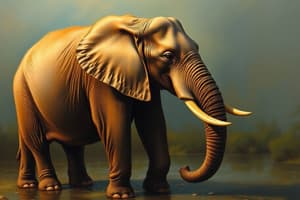Podcast
Questions and Answers
What is the main function of the trunk of elephants?
What is the main function of the trunk of elephants?
- Singing, dancing, painting, and writing
- Grasping objects, smelling, breathing, trumpeting, and spraying water (correct)
- Flying, jumping, swimming, and digging
- Reading, typing, calculating, and cooking
What are groups of elephants led by?
What are groups of elephants led by?
- Elders
- Babies
- Females (correct)
- Males
How do elephants communicate over long distances?
How do elephants communicate over long distances?
- By sending emails
- Using vibrations produced by foot strikes (correct)
- Through telepathy
- Through radio waves
What threatens the conservation of African elephants?
What threatens the conservation of African elephants?
What role do related females play in elephant groups?
What role do related females play in elephant groups?
What helps improve conservation efforts for elephants?
What helps improve conservation efforts for elephants?
What is the maximum weight an adult elephant can weigh?
What is the maximum weight an adult elephant can weigh?
Which type of elephant has loose folds of skin hanging down to their bellies?
Which type of elephant has loose folds of skin hanging down to their bellies?
What are elephant tusks primarily made of?
What are elephant tusks primarily made of?
Which gender of elephant typically has taller ears, a larger head, and more prominent creases on its face?
Which gender of elephant typically has taller ears, a larger head, and more prominent creases on its face?
What characteristic is unique to female Asian elephants compared to female African elephants?
What characteristic is unique to female Asian elephants compared to female African elephants?
What feature is absent in Asian elephants but present in African elephants' skin?
What feature is absent in Asian elephants but present in African elephants' skin?
Flashcards are hidden until you start studying
Study Notes
Elephants
Elephants, known scientifically as Loxodonta africana, are large mammals native to Africa and Southeast Asia. They have been around for millions of years and have played a significant role in various cultures throughout history. Here's what you need to know about these majestic creatures.
Physical Characteristics
- Size: Adult elephants can weigh up to 7 tons and stand over 13 feet tall when measured from their shoulders to the ground. Their height is usually between 8 ft. and 9 ft., depending on the gender of the animal.
- Body Structure: An adult male African elephant typically has taller ears, larger head, longer nose, thicker skin, more extensive hair, and more prominent creases on its face compared to females. A female Asian elephant tends to be smaller and has less body hair while also having two noticeable protruding parts at the back of her skull called osteoderms.
- Skin: African elephants possess loose folds of skin hanging down to their bellies while Asian elephants do not have this characteristic; instead, they have wrinkled skin with non-extending skin folds.
- Tusks: Both males and females may develop tusks which are actually elongated upper incisors made of ivory. However, only half of all mature African elephants will grow them because it depends largely on genetics.
- Trunk: One distinctive feature of both species is their trunk which serves multiple functions such as grasping objects, smelling, breathing, trumpeting, and spraying water into their mouths.
Behavior
- Social Life: Elephants live in groups called towers led by matriarchal structures where females make most decisions, including choosing routes and calming other members when needed. These groups consist of related females who help each other care for their young ones. Although they don't migrate like some species do, they move constantly within a defined home range searching for food and water.
- Communication: In addition to vocalizations, elephants communicate through vibrations produced by foot strikes against hard surfaces, which transmit messages through the ground long distances. This form of communication is used especially during courtship rituals and disputes.
Conservation Status
Due to human activity such as poaching, deforestation, habitat loss, and conflict with humans (particularly farmers), the World Wildlife Fund considers African elephants endangered whereas the status of Asian elephants varies across regions ranging from near threatened to critically endangered due to fragmented populations, limited gene pools, and ongoing threats. Protective measures including laws banning hunting and trading ivory products have helped improve conservation efforts.
Studying That Suits You
Use AI to generate personalized quizzes and flashcards to suit your learning preferences.





